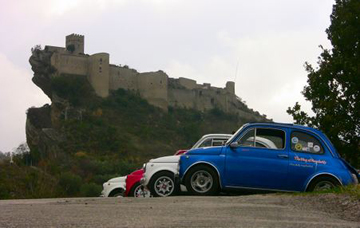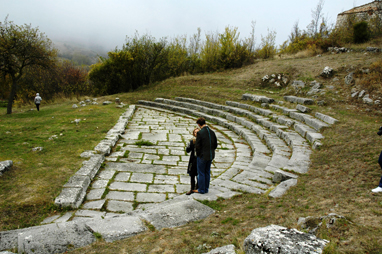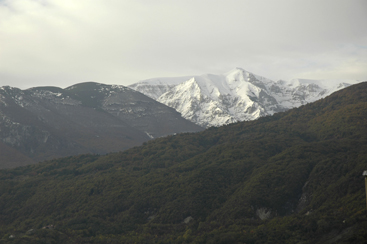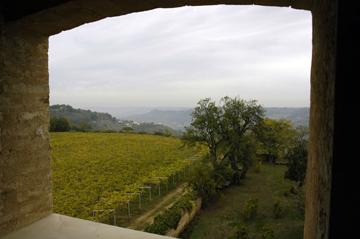|
Travels in Geology February 2008 posted February 19, 2008
Exploring Abruzzo by Cinquecento
Jordan Clary
 Richard Truesdell: automotivetraveler.com |
| Winding through the hillsides of Abruzzo, Italy, in a vintage Fiat 500, otherwise known as the Cinquecento, feels very old worldly. Stop at locations such as the castle ruins above Roccascalegna to experience old world Italy. |
Traveling through central Italy’s Abruzzo region in a vintage Fiat 500, also known as the Cinquecento (Italian for 500), feels like an appropriate way of exploring the abundant geo-offerings of the area. Italy, after all, is a rich combination of history, art and stunning natural wonders, and the Fiat, which looks a little like a brightly colored metal mouse, has become a classic icon of the country. Abruzzo, lesser known and less frequently traveled than its more famous neighbor, Tuscany, is a fascinating place to zip along winding country roads past hillsides of vineyards, pastureland, along the rocky Adriatic coast and through craggy mountain passes. And what better time to go than winter, when airfares to Italy are low and the weather is less than ideal in many parts of the Northern Hemisphere, but still beautiful in Italy.
Though your adventures in Abruzzo could include any number of geologic, gastronomic or historic excursions, if you want to get a real sense of the place, try to limit your plans to one or two areas. (Plus, that gives you an excuse to go back more often.) Our journey concentrated on Chieti Province, which stretches between the Adriatic and the Maiella Mountain Range. The Pescara River borders the province in the north and the Tirgino lies to the south. Within these boundaries lie rivers and rich meadows, ancient archaeological ruins and medieval villages.
 Claire Bowen |
| The amphitheater at Juvanum, outside Montenerodomo, is part of a mass of ruins dating back to the 7th century B.C. |
Religion has always played a strong part in Italy’s culture. Near the village of Montenerodomo lay the ruins of Juvanum, one of central Italy’s most important archaeological sites where man’s homage to the gods can be traced from protohistory through the Middle Ages. The remains of the megalithic walls date back to the time that the Celtic Frentano Tribe inhabited the area, from approximately the 7th to 2nd centuries B.C. The large complex, which also served as a market and meeting area during its many transitions of power, holds the remains of a temple that was believed to be the “Seat of the Sky God,” a Celtic deity. As the Romans moved in and conquered the area at the end of the Social War (91 to 88 B.C.), two temples were built on the spot dedicated to Hercules and several country goddesses. Finally, during the Middle Ages, Juvanum became the home of a large Christian monastery. Although only a small portion of this site has been excavated, it gives a visual record of both the cultural and natural changes that have occurred over time.
Along the old Roman road that runs outside the ruins, one can still see evidence of an earthquake that shook the area in A.D. 354, such as land displacement and fissures in the rocks of the road. The rocky pastureland surrounding the road offers grazing to herds of sheep and goats as it has for hundreds of years.
Rock hounds will find plenty of places to indulge their passions in the Abruzzo region. Many of the villages seem to be carved out of the very hills. One such place is Gessopalena, a town of approximately 1,700 people, which has earned the moniker, “a village built on chalk” because of the many chalk quarries surrounding it. Gessopalena still has a strong medieval flavor to its narrow, winding alleys and ancient walls. Some of the buildings seem to be literally dangling in mid-air from the limestone rocks. Ancient ruins dating back to pre-Roman times can be found in the surrounding area. Re-creations of historic or religious events are frequently performed in the town center. And, as in other parts of this region, you’ll find a delectable cuisine that includes a number of lamb dishes flavored with local herbs and vegetables.
 Claire Bowen |
| The Maiella, a single massif mountain, rises over the countryside. It is part of the Morrone range and offers great hiking and geological exploration, especially in the summer. |
Nearby, the stunningly beautiful Maiella, a single massif mountain, rises over the countryside. Dedicated to Maja, the Goddess of Fertility, Maiella is called “The Great Mother” by the locals and is said to symbolize the reawakening of nature. The Maiella, which is part of the Morrone range, is a complex mixture of karst terrain, rocky gorges and spruce forest that gives way to alpine plants near the summit. The Morrone are a young range formed mostly from carbonatic rocks that surfaced from the ancient Tetide Sea about 5 million years ago. Shark teeth, coral, rudistids, ammonite and nummulite fossils are frequently found. The east side of the Morrone range is rugged and steep with plunging ravines and deep glacial valleys. The western side is gentler, comprised of a terrace formed by a fault that runs from north to south. Among the karst ledges are deep caves that once housed paleolithic hunters. Later these caves served as shelters for shepherds, Christian hermits and small monastic communities. The largest of these caves is Cavallone. These caves can be explored but with great care. Steps are carved into the rock but it is incredibly steep and best explored during the summer, due to winter’s sometimes unpredictable weather. This area is considered one of the wildest parts of Italy.
Abundant wildlife, including the elusive Apennine wolf, deer and roebuck, the European wildcat and the brown Marsican bear, makes its home in this wilderness. The precipitous cliffs offer shelter to the golden eagle, peregrine falcon and the rare lanner falcon.
 Claire Bowen |
| No visit to Italy is complete without partaking in some of the country's famed cuisine and wine. In Abruzzo, be sure to visit the Masciarelli Vineyard, where a 16th century castle has been restored to a luxury hotel with a stunning view of the Adriatic. |
No trip to Italy is complete without partaking of some of the finest food and wine on the planet. Wine has been popular in the Abruzzo area since long before the Roman age. Abruzzo has some of the oldest vineyards in the country. Two places well worth visiting are the Gianni Masciarelli Vineyard and Cantina Frentana in Rocca San Giovanni.
The Gianni Masciarelli Vineyard is in the centuries-old village of San Martino sulla Marrucina, about two hours from Rome.The fluctuations between night and day temperatures and the limestone soil, rich in minerals, make for strong and resilient grape and olive plants. It is also possible to lodge at the Masciarelli Vineyard. A 16th century baron’s castle next to the vineyard has recently been restored to a luxury hotel with a stunning vista of the Adriatic. The onsite restaurant also offers cooking lessons to learn how to make local pastries and other dishes.
The Cantina Frentana in the small village of Rocca San Giovanni about 30 kilometers away from Gianni Masciarelli also offers some excellent vintages. Rocca San Giovanni is a charming and hilly town along the Adriatic coast. It’s easy to spend a day wandering around the winding streets of ancient stone buildings. And for dinner, you can enjoy the day’s catch at a trabocchi, one of the wooden piers that also serves as a restaurant and where you are sure to relish some of the freshest, tastiest seafood imaginable.
One of the most rewarding aspects of Italy’s Abruzzo region is that, unlike Italy’s “hotspots” — Tuscany or the resorts along the Mediterranean — it is not touristy. It is also one of the most affordable areas of this intriguing country where the people are friendly and the hospitality is unsurpassed. The geology of the area is waiting to be explored. What are you waiting for?
Links:
Geotours by Fiat 500 by Leondardo De Flavis
Custom tours of Italy - Your Friend in Italy
Abruzzo Tourism from In Italy Online
Back to top

 Subscribe
Subscribe


